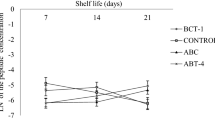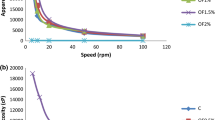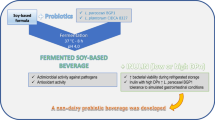Abstract
The potential for reusability of whey is of concern due to its substantial nutritional value and, second, in view of the need to reduce environmental impact. The use of goat whey powder in the production of a fermented dairy beverage using a Lactobacillus casei culture as adjunct shows a good prospect of a food product with hypotensive activity. This study investigated the microbial viability, proteolysis and angiotensin-converting enzyme (ACE) inhibitory activity of a fermented dairy beverage produced with goat whey powder and a probiotic culture of L. casei BGP93 co-cultured with Streptococcus thermophilus TA-40. The probiotic beverage exhibited no significant difference from the control (absence of L. casei) with regard to titratable acidity, S. thermophilus viability and proteolysis degree during 21 days of storage (P > 0.05). During this period, the beverage maintained L. casei at appropriate levels (> 7 log cfu ml−1), thereby qualifying as a potential probiotic product. Although both control and probiotic beverages exhibited ACE inhibitory activity, as a result of proteolysis of whey proteins during fermentation, significant increased ACE inhibitory activity was found for the beverage with added probiotic L. casei (P < 0.05). The probiotic beverage has potency as a functional food candidate to be included in a dietary strategy aiming at prevention and control of hypertension.




Similar content being viewed by others
References
Minervini F, Bilancia MT, Siragusa S, Gobbetti M, Caponio F (2009) Fermented goats’ milk produced with selected multiple starters as a potentially functional food. Food Microbiol 26(6):559–564. https://doi.org/10.1016/j.fm.2009.03.008
Hernández-Ledesma B, Contreras MM, Recio I (2011a) Antihypertensive peptides: production, bioavailability and incorporation into foods. Adv Colloid Interf Sci 165(1):23–35. https://doi.org/10.1016/j.cis.2010.11.001
Abd El-Salam MH, El-Shibiny S (2013) Bioactive peptides of buffalo, camel, goat, sheep, mare, and yak milks and milk products. Food Rev Int 29(1):1–23. https://doi.org/10.1080/87559129.2012.692137
Seppo L, Jauhiainen T, Poussa T, Korpela R (2003) A fermented milk high in bioactive peptides has a blood pressure-lowering effect in hypertensive subjects. Am J Clin Nutr 77(2):326–330
Didelot S, Bordenave-Juchereau S, Rosenfeld E, Fruitier-Arnaudin I, Piot J, Sannier F (2006a) Preparation of angiotensin-I converting enzyme inhibitory hydrolysates from unsupplemented caprine whey fermentation by various cheese microflora. Int Dairy J 16(9):976–983. https://doi.org/10.1016/j.idairyj.2005.09.009
Donkor ON, Henriksson A, Singh TK, Vasiljevic T, Shah NP (2007) ACE inhibitory activity of probiotic yoghurt. Int Dairy J 17(11):1321–1331. https://doi.org/10.1016/j.idairyj.2007.02.009
Hamme V, Sannier F, Piot JM, Didelot S, Bordenave-Juchereau S (2009) Crude goat whey fermentation by Kluyveromyces marxianus and Lactobacillus rhamnosus: contribution to proteolysis and ACE inhibitory activity. J Dairy Res 76(02):152–157. https://doi.org/10.1017/S0022029908003877
Hill C, Guarner F, Reider G, Gibson GR, Merenstein DJ, Pot B, Morelli L, Canini RB, Flint HJ, Salminen S, Calder PC, Sanders ME (2014) The International Scientific Association for Probiotics and Prebiotics consensus statement on the scope and appropriate use of the term probiotic. Nat Rev Gastroenterol Hepatol 11(8):506–514. https://doi.org/10.1038/nrgastro.2014.66
Martinez RCR, Bedani R, Saad SMI (2015) Scientific evidence for health effects attributed to the consumption of probiotics and prebiotics: an update for current perspectives and future challenges. Br J Nutr 114(12):1993–2015. https://doi.org/10.1017/S0007114515003864
Buriti FCA, Saad SMI (2007) Bacteria of Lactobacillus casei group: characterization, viability as probiotic in food products and their importance for human health. Arch Latinoam Nutr 57(4):373–380
Ma C, Gong G, Liu Z, Ma A, Chen Z (2015a) Stimulatory effects of tea supplements on the propagation of Lactobacillus casei in milk. Int Dairy J 43:1–6. https://doi.org/10.1016/j.idairyj.2014.10.003
Salva S, Nuñez M, Villena J, Ramón A, Font G, Alvarez S (2011) Development of a fermented goats’ milk containing Lactobacillus rhamnosus: in vivo study of health benefits. J Sci Food Agric 91(13):2355–2362. https://doi.org/10.1002/jsfa.4467
dos Santos KMO, Bomfim MAD, Vieira ADS, Benevides SD, Saad SMI, Buriti FCA, Egito AS (2012) Probiotic caprine Coalho cheese naturally enriched in conjugated linoleic acid as a vehicle for Lactobacillus acidophilus and beneficial fatty acids. Int Dairy J 24(2):107–112. https://doi.org/10.1016/j.idairyj.2011.12.001
Senaka Ranadheera C, Evans CA, Adams MC, Baines SK (2012) Probiotic viability and physico-chemical and sensory properties of plain and stirred fruit yogurts made from goat’s milk. Food Chem 135(3):1411–1418. https://doi.org/10.1016/j.foodchem.2012.06.025
Meira QGS, Magnani M, Medeiros Júnior FC, Queiroga RCRE, Madruga MS, Gullón B, Gomes AMP (2015) Effects of added Lactobacillus acidophilus and Bifidobacterium lactis probiotics on the quality characteristics of goat ricotta and their survival under simulated gastrointestinal conditions. Food Res Int 76(Pt 3):828–838. https://doi.org/10.1016/j.foodres.2015.08.002
Park YW, Juárez M, Ramos M, Haenlein GFW (2007) Physico-chemical characteristics of goat and sheep milk. Small Rumin Res 68(1-2):88–113. https://doi.org/10.1016/j.smallrumres.2006.09.013
Ribeiro AC, Ribeiro SDA (2010) Specialty products made from goat milk. Small Rumin Res 89(2-3):225–233. https://doi.org/10.1016/j.smallrumres.2009.12.048
Tranjan B, Cruz AG, Walter EHM, Faria JAF, Bolini HMA, Moura MRL, Carvalho LMJ (2009) Development of goat cheese whey-flavoured beverages. Int J Dairy Technol 62(3):438–443. https://doi.org/10.1111/j.1471-0307.2009.00491.x
Buriti FCA Freitas SC, Egito AS, dos Santos KMO (2014) Effects of tropical fruit pulps and partially hydrolysed galactomannan from Caesalpinia pulcherrima seeds on the dietary fibre content, probiotic viability, texture and sensory features of goat dairy beverages. LWT - Food Sci Technol 59(1):196–203. https://doi.org/10.1016/j.lwt.2014.04.022
da Silveira EO, Lopes Neto JH, Silva LAD, Raposo AES, Magnani M, Cardarelli HR (2015) The effects of inulin combined with oligofructose and goat cheese whey on the physicochemical properties and sensory acceptance of a probiotic chocolate goat dairy beverage. LWT – Food Sci Technol 62(1):445–451. https://doi.org/10.1016/j.lwt.2014.09.056
Ibrahim HR, Ahmed AS, Miyata T (2017) Novel angiotensin-converting enzyme inhibitory peptides from caseins and whey proteins of goat milk. J Adv Res 8(1):63–71. https://doi.org/10.1016/j.jare.2016.12.002
Wendorf W (2008) Uses of whey in the farmstead setting. Wisconsin Department of Agriculture, Trade and Consumer Protection, Madison
Egito AS, Laguna LE (1999) Fabricação de queijo de Coalho com leite de cabra. Circular Técnica 16. Empresa Brasileira de Pesquisa Agropecuária, Brasília
IAL (2008) Métodos físico-químicos para análise de alimentos, 4th edn. Instituto Adolfo Lutz, São Paulo
Richter RL, Vedamuthu ER (2001) In: Compendium of the methods for the microbiological examination of foods, 4th edn. APHA, Washington
AOAC International (2003) Official methods of analysis of the AOAC International. 17th edn, 2nd rev. AOAC International, Gaithersburg
Church FC, Swaisgood HE, Porter DH, Catignani GL (1983) Spectrophotometric assay using o-phthaldialdehyde for determination of proteolysis in milk and isolated milk proteins. J Dairy Sci 66(6):1219–1227. https://doi.org/10.3168/jds.S0022-0302(83)81926-2
dos Santos KMO, Vieira ADS, Salles HO, Oliveira JS, Rocha CRC, Borges MF, Bruno LM, Franco BDGMF, Todorov SD (2015) Safety, beneficial and technological properties of Enterococcus faecium isolated from Brazilian cheeses. Braz J Microbiol 46(1):237–249. https://doi.org/10.1590/S1517-838246120131245
Laemmli UK (1970) Cleavage of structural proteins during the assembly of the head of the bacteriophage t4. Nature 227(5259):689–695. https://doi.org/10.1038/227680a0
Cushman DW, Cheung HS (1971) Spectrophotometric assay and properties of the angiotensin-converting enzyme of rabbit lung. Biochem Pharmacol 20(7):1637–1648. https://doi.org/10.1016/0006-2952(71)90292-9
Donkor ON, Henriksson A, Vasiljevic T, Shah NP (2005) Probiotic strains as starter cultures improve angiotensin-converting enzyme inhibitory activity in soy yogurt. J Food Sci 70(8):M375–M381. https://doi.org/10.1111/j.1365-2621.2005.tb11522.x
Vinderola CG, Moocchiutti P, Reinheimer JA (2002) Interactions among lactic acid starter and probiotic bacteria used for fermented dairy products. J Dairy Sci 85(4):721–729. https://doi.org/10.3168/jds.S0022-0302(02)74129-5
Ma C, Ma A, Gong G, Liu Z, Wu Z, Guo B, Chen Z (2015b) Cracking Streptococcus thermophilus to stimulate the growth of the probiotic Lactobacillus casei in co-culture. Int J Food Microbiol 210:42–46. https://doi.org/10.1016/j.ijfoodmicro.2015.04.034
Pescuma M, Hébert EM, Bru E, Font de Valdez G, Mozzi F (2012) Diversity in growth and protein degradation by dairy relevant lactic acid bacteria species in reconstituted whey. J Dairy Res 79(02):201–208. https://doi.org/10.1017/S0022029912000040
Brasil. Ministério da Agricultura, Pecuária e Abastecimento (2005) Instrução normativa n. 16, de 23 de agosto de 2005. Aprova o regulamento técnico de identidade e qualidade de bebidas lácteas. Diário Oficial da União, 24 August (163):7–10
Atasanova J, Moncheva P, Ivanova I (2014) Proteolytic and antimicrobial activity of lactic acid bacteria grown in goat milk. Biotechnol Biotechnol Equip 28(6):1073–1078. https://doi.org/10.1080/13102818.2014.971487
Pescuma M, Hébert EM, Mozzi F, Font de Valdez G (2007) Hydrolysis of whey proteins by Lactobacillus acidophilus, Streptococcus thermophilus and Lactobacillus delbrueckii ssp. bulgaricus grown in a chemically defined medium. J Appl Microbiol 103(5):1738–1746. https://doi.org/10.1111/j.1365-2672.2007.03404.x
Didelot S, Bordenave-Juchereau S, Rosenfeld E, Piot J, Sannier F (2006b) Peptides released from acid goat whey by a yeast-lactobacillus association isolated from cheese microflora. J Dairy Res 73(02):163–170. https://doi.org/10.1017/S0022029905001512
Hernández-Ledesma B, Ramos M, Gómez-Ruiz JA (2011b) Bioactive components of ovine and caprine cheese whey. Small Rumin Res 101(1-3):196–204. https://doi.org/10.1016/j.smallrumres.2011.09.040
Acknowledgements
The authors wish to thank the Danisco Brasil Ltda. for providing part of the materials used in this study and the Laboratory of Food Science and Technology/Embrapa Goats and Sheep for their technical assistance.
Funding
This study was supported by the Conselho Nacional de Desenvolvimento Científico e Tecnológico (CNPq, Projects 477799/2012-4, 157376/2014-1 and 137976/2015-1), Coordenação de Aperfeiçoamento de Pessoal de Nível Superior (CAPES), Brazilian Agricultural Research Corporation (EMBRAPA) and Fundação Parque Tecnológico da Paraíba (PaqTcPB).
Author information
Authors and Affiliations
Corresponding author
Ethics declarations
Conflict of Interests
The authors declare that they have no conflict of interest.
Rights and permissions
About this article
Cite this article
Pereira, Á.M.d.S., de Farias, D.R.B., de Queiroz, B.B. et al. Influence of a Co-culture of Streptococcus thermophilus and Lactobacillus casei on the Proteolysis and ACE-Inhibitory Activity of a Beverage Based on Reconstituted Goat Whey Powder. Probiotics & Antimicro. Prot. 11, 273–282 (2019). https://doi.org/10.1007/s12602-017-9362-y
Published:
Issue Date:
DOI: https://doi.org/10.1007/s12602-017-9362-y




